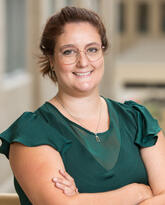
Ana Paula Arantes
Postdoctoral Fellow (Alumna)
Contact information
Biography
About me
Ana Paula Arantes is an accomplished researcher whose passion for innovation in biomedical engineering has defined her academic and professional journey. Graduating with distinction in Biomedical Engineering in 2012, she excel in a master's program focused on sensor integration for upper limb prostheses, where she not only honed her skills but also contributed significantly to industry-academia partnerships, resulting in patented. Ana pursued a Ph.D. in Biomedical Engineering at the University of New Brunswick, where she developed groundbreaking haptic systems for upper limb rehabilitation. Her doctoral journey was marked by prolific research contributions, encompassing the development of software, hardware, and extensive clinical studies, showcasing her commitment to advancing rehabilitation technology. Ana's academic pursuit continued as a postdoctoral fellow at the University of Calgary's Department of Clinical Neuroscience. Here, she delved into cutting-edge research in neuromodulation methods including deep brain stimulation, transcranial magnetic stimulation and low intensity ultrasound. Her contributions earned her prestigious recognition, including the Brain Create Neurotechnology fellowship, emphasizing her commitment to interdisciplinary research. Beyond her academic pursuits, Ana is deeply engaged in community initiatives, serving as a chapter leader for Makers Making Change, fostering partnerships to enhance accessibility for people with disabilities. Ana Paula Arantes stands as a beacon of innovation and dedication in the field of biomedical engineering, continuously pushing boundaries and making impactful strides in technology-driven solutions.
My research
The first part of the project we studied how a treatment called deep brain stimulation (DBS) helps people with a movement disorder called dystonia. We used a method involving magnetic pulses and nerve stimulation. We found that SAI was within normal range in subjects with dystonia compared to age- and sex-matched controls. Additionally, DBS being ON or OFF did not alter SAI measured. Now we started to explore a new potential treatment for dystonia called low-intensity focused ultrasound (LIFU). We want to test this method before trying a more permanent brain treatment called high focuses ultrasound (HIFU). The aim is to use LIFU to temporarily reduce the uncontrollable movements caused by dystonia and essencial tremor, especially in people considering a more intense ultrasound treatment. By doing this, they hope to create a safe and affordable way to test treatments for dystonia and essencial tremor before patients undergo more invasive procedures. We are also developing an movement tracker to measure the head position during the procedure to quantify the effects on these patients. This could make a big difference for people with this condition.
BRAIN CREATE program aspirations
I'm thrilled to be involved in advancing cutting-edge technology aimed at enhancing the lives of individuals affected by dystonia and essential tremor. I am hopping to be able to have an industrial experience.
Commercialization
Low-intensity focused ultrasound (LIFU) is a new cutting-edge non-invasive medical technology. No one has ever reported using neuromodulatory LIFU supress tremor, without heating the brain, as an exploratory mapping tool prior to surgery. There are just few LIFU equipments commercially available and a few being studied. If this method works as expected, we believe new LIFUequipments should emerge from this. Our motion tracker system is also new and is being developed in our lab.
Publications
Awards
Collaborator Brain Create trainee program 2021
Collaborator New Brunswick Innovation Foundation Funding Sources 2019
Principal Applicant Coordination for the Improvement of Higher Education CAPES 2015
Principal Applicant FAPEMIG 2014

